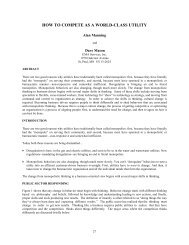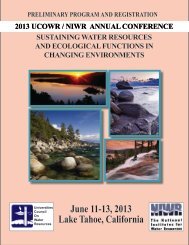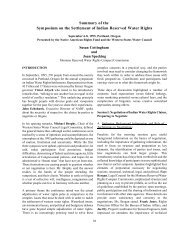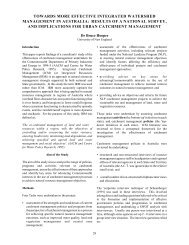Full Journal of Contemporary Water Research and Education, Issue ...
Full Journal of Contemporary Water Research and Education, Issue ...
Full Journal of Contemporary Water Research and Education, Issue ...
Create successful ePaper yourself
Turn your PDF publications into a flip-book with our unique Google optimized e-Paper software.
100UNIVERSITIES COUNCIL ON WATER RESOURCESJOURNAL OF CONTEMPORARY WATER RESEARCH & EDUCATIONISSUE 135, PAGES 100-106, DECEMBER 2006From Value to Finance: Making IWRM WorkBen Lamoree <strong>and</strong> Frank van SteenbergenArcadis EuroconsultThe discussion on Integrated <strong>Water</strong>Resource Management (IWRM) has beenvery rich on institutional change (basinorganizations, apex water bodies, legal reform)<strong>and</strong> on process management (multi-stakeholderprocesses, consultation <strong>and</strong> participation), but attentionto the financial dimension <strong>of</strong> IWRM has been lessdeveloped.The gist <strong>of</strong> IWRM is that in water managementthere are many different functions to be managedsimultaneously. Through investment <strong>and</strong> managementinterventions, values are created (or destroyed)in connection to these functions: productivity values,amenity values, property values, environmentalconservation values, <strong>and</strong> more. The challenge inIWRM is to, at a minimum, balance these differentfunctions <strong>and</strong> values, yet preferably to optimizethem. This paper further argues that these differentvalues need to be captured <strong>and</strong>, when possible,help finance the management <strong>of</strong> water resourcesystems in an integrated way. We present this asan improvement <strong>of</strong> the principle <strong>of</strong> “water as aneconomic good.” The economic good argumenthas, in our view, <strong>of</strong>ten led to reductionist strategies,focusing on recovering the financial cost <strong>of</strong> wateronly <strong>and</strong> not maximizing <strong>and</strong> recovering the valuesassociated with the many functions <strong>of</strong> water.This paper first clarifies some definitions <strong>and</strong>then discusses how to capture values <strong>and</strong> turnthem into financial contributions to IWRM usingillustrations from several parts <strong>of</strong> the world. Thepaper then comments on the principle <strong>of</strong> water asan economic good, long considered as the financialunderpinning <strong>of</strong> IWRM. We look particularly atwater pricing for dem<strong>and</strong> management, closelyassociated with the theory <strong>of</strong> water as an economicgood. It argues that a broader financial strategy,based on balancing, improving, <strong>and</strong> capitalizingon increased values related to water management,is more promising in funding IWRM <strong>and</strong> makingit work. Finally, some institutional aspects <strong>of</strong> thisapproach are explored.Functions <strong>and</strong> ValuesThe concept <strong>of</strong> functions describes the goods<strong>and</strong> services the natural resource system providesor performs. There is almost always a wide range<strong>of</strong> functions associated with any given resourcesystem (Abdel Dayem et al. 2004). Table 1, forinstance, is a list <strong>of</strong> functions associated withirrigated areas. Other lists can be produced forother natural resource systems.Values is the concept through which societalpreferences, perceptions, <strong>and</strong> interests with regardto functions provided by natural resources areexpressed. These values are social, economic,financial <strong>and</strong> (temporal <strong>and</strong> spatial) ecologicalvalues. Values should not be seen separate fromstakeholders. They are not general <strong>and</strong> abstract,but they are always values to stakeholders. Thesemay be farmers, property owners, industries, localtowns, livestock owners, fishermen, <strong>and</strong> so forth<strong>and</strong>, in many cases, the public at large.The point <strong>of</strong> such lists is that there is usuallya large number <strong>of</strong> functions, many <strong>of</strong> which inpractice are overlooked in resource management,if only because the organizations that arepractically managing the resource have a limitedagenda <strong>and</strong> m<strong>and</strong>ate. In the management process,important opportunities to create value for variousstakeholders are missed.Quite typically the many functions in irrigationUCOWRJOURNAL OF CONTEMPORARY WATER RESEARCH & EDUCATION








